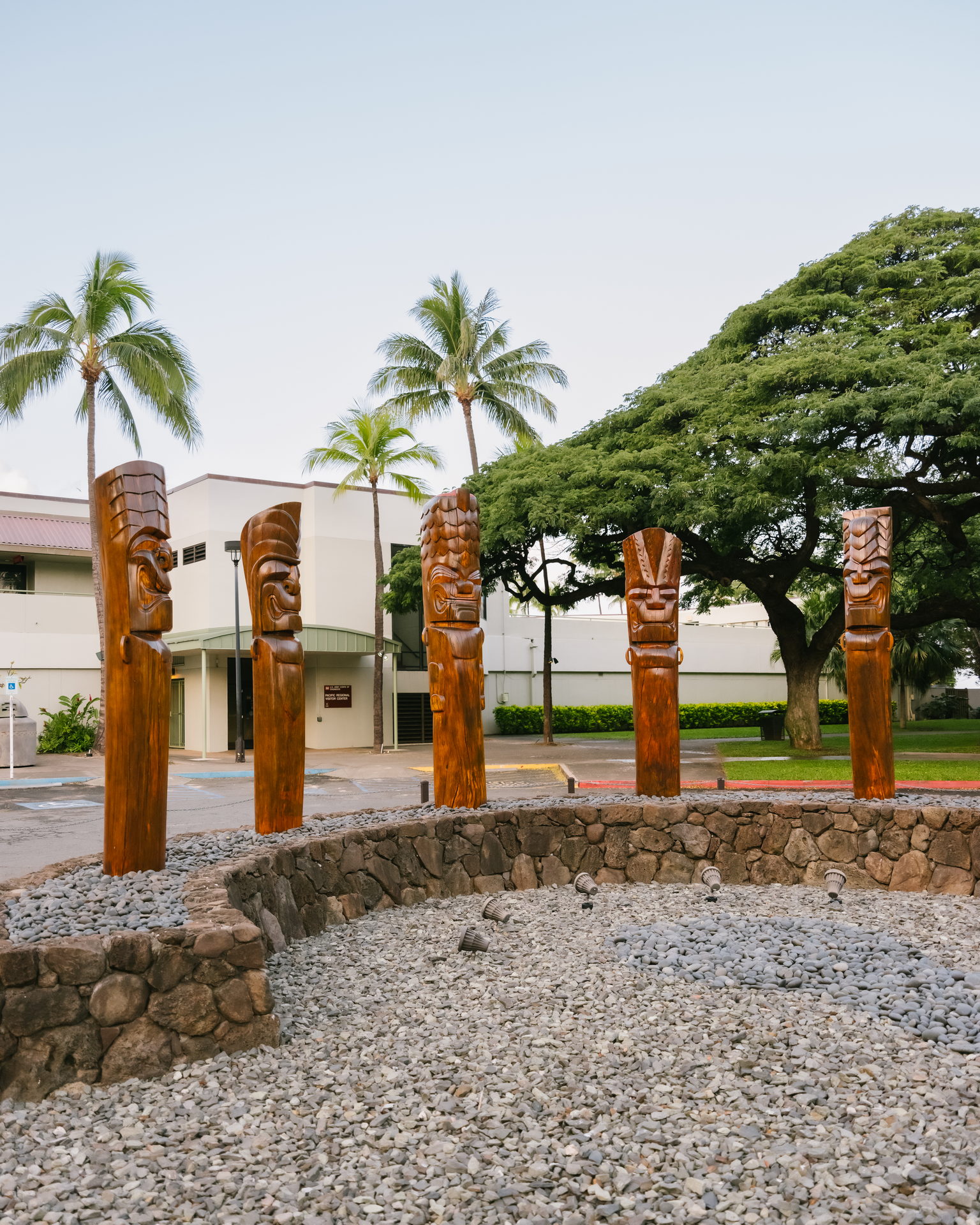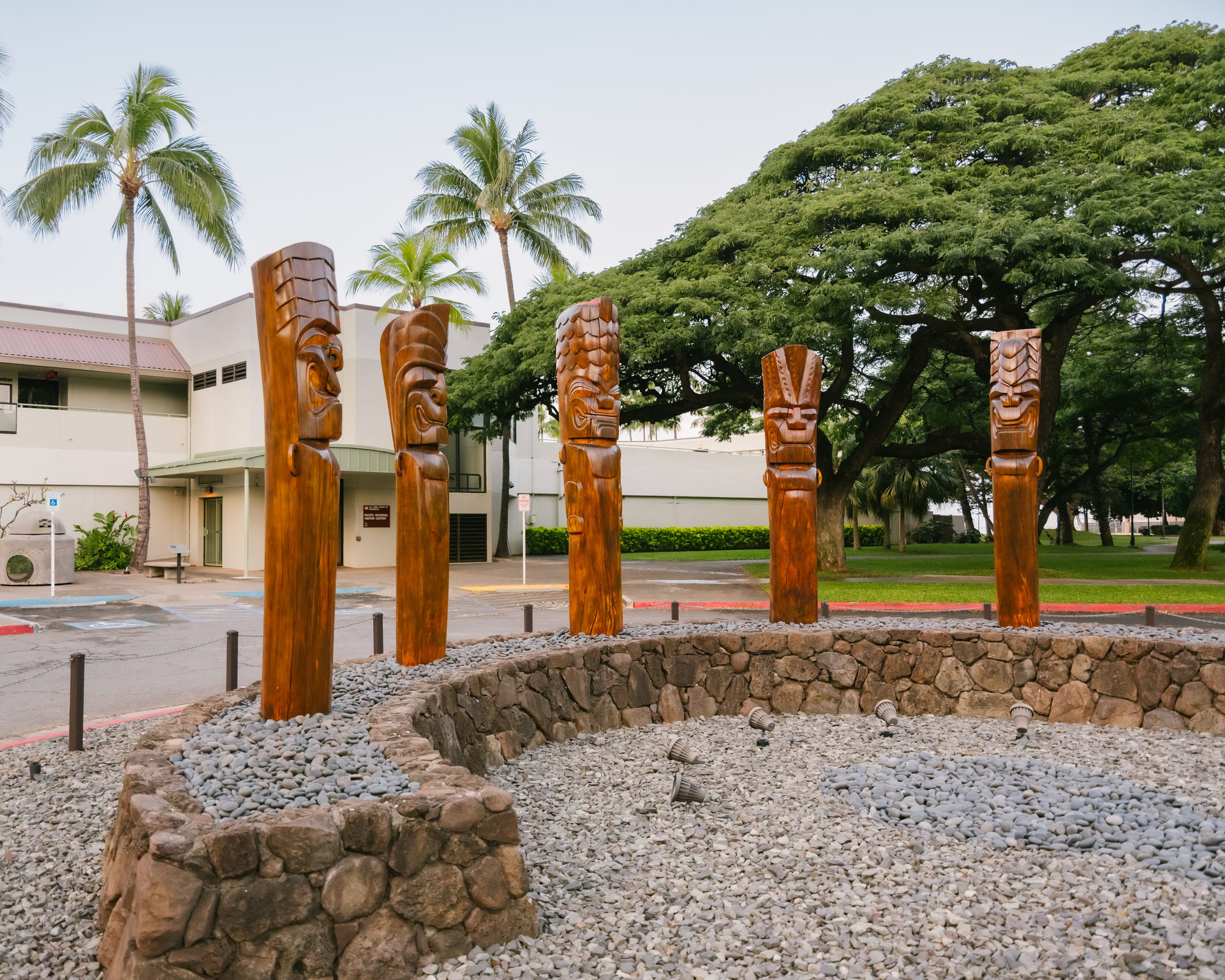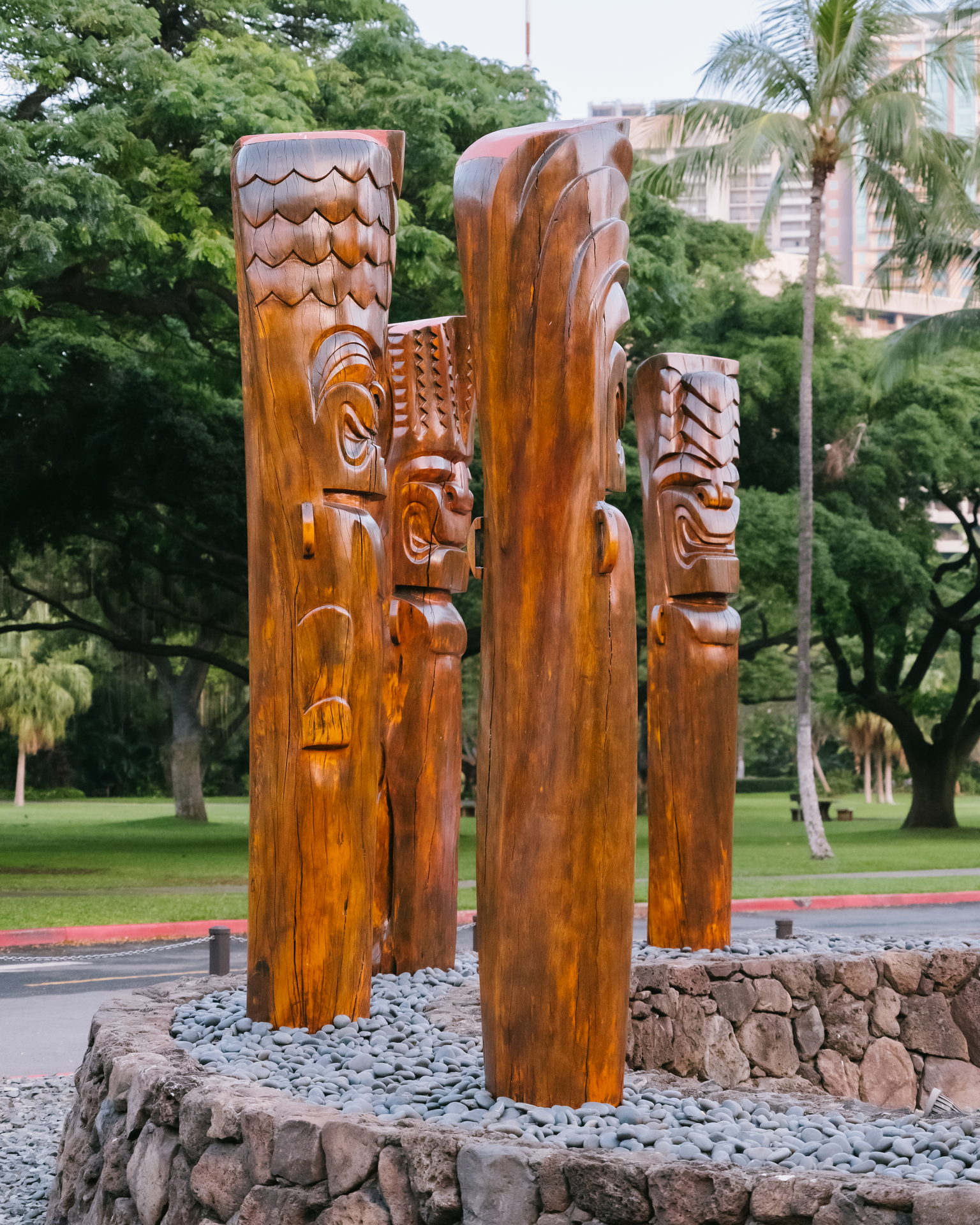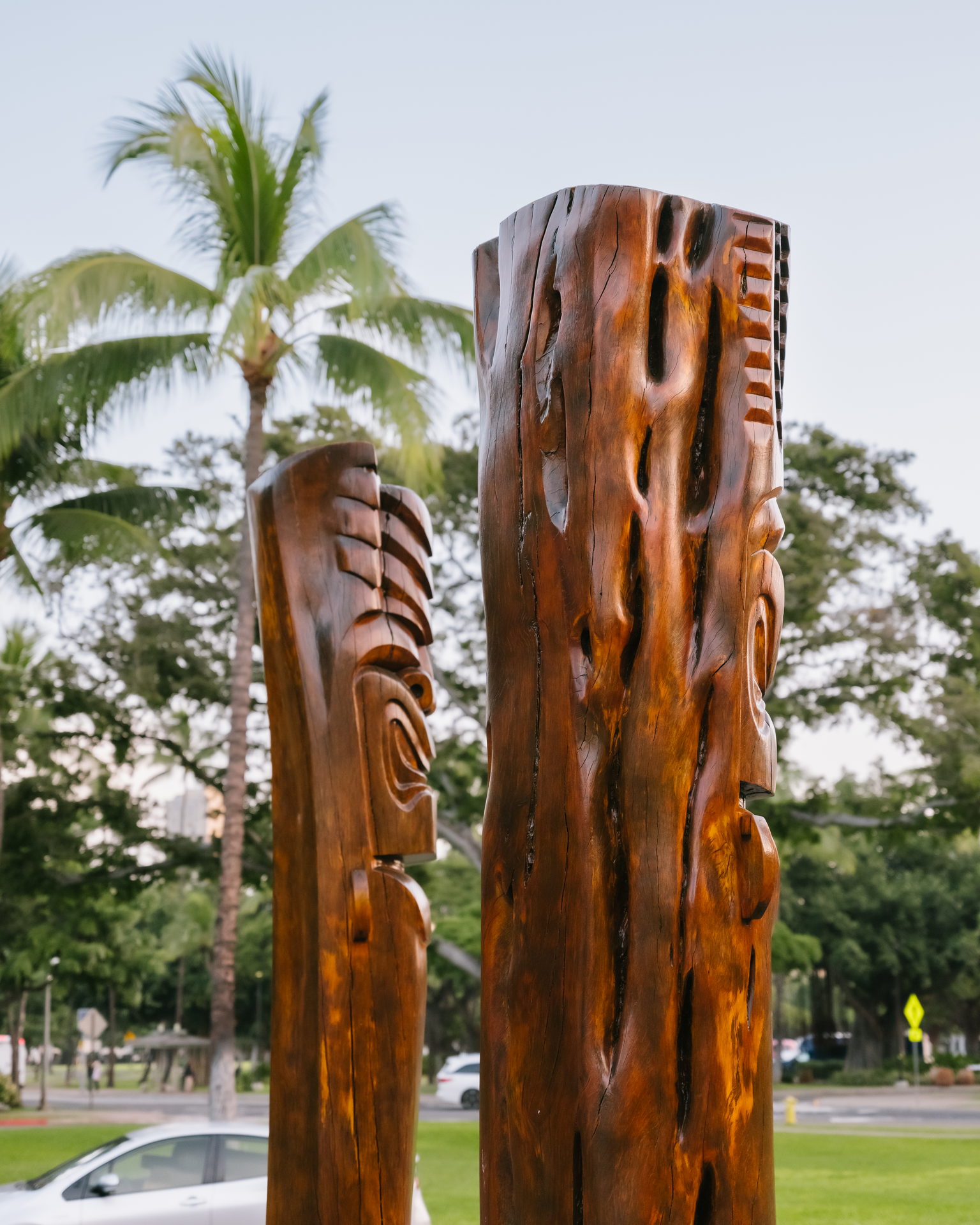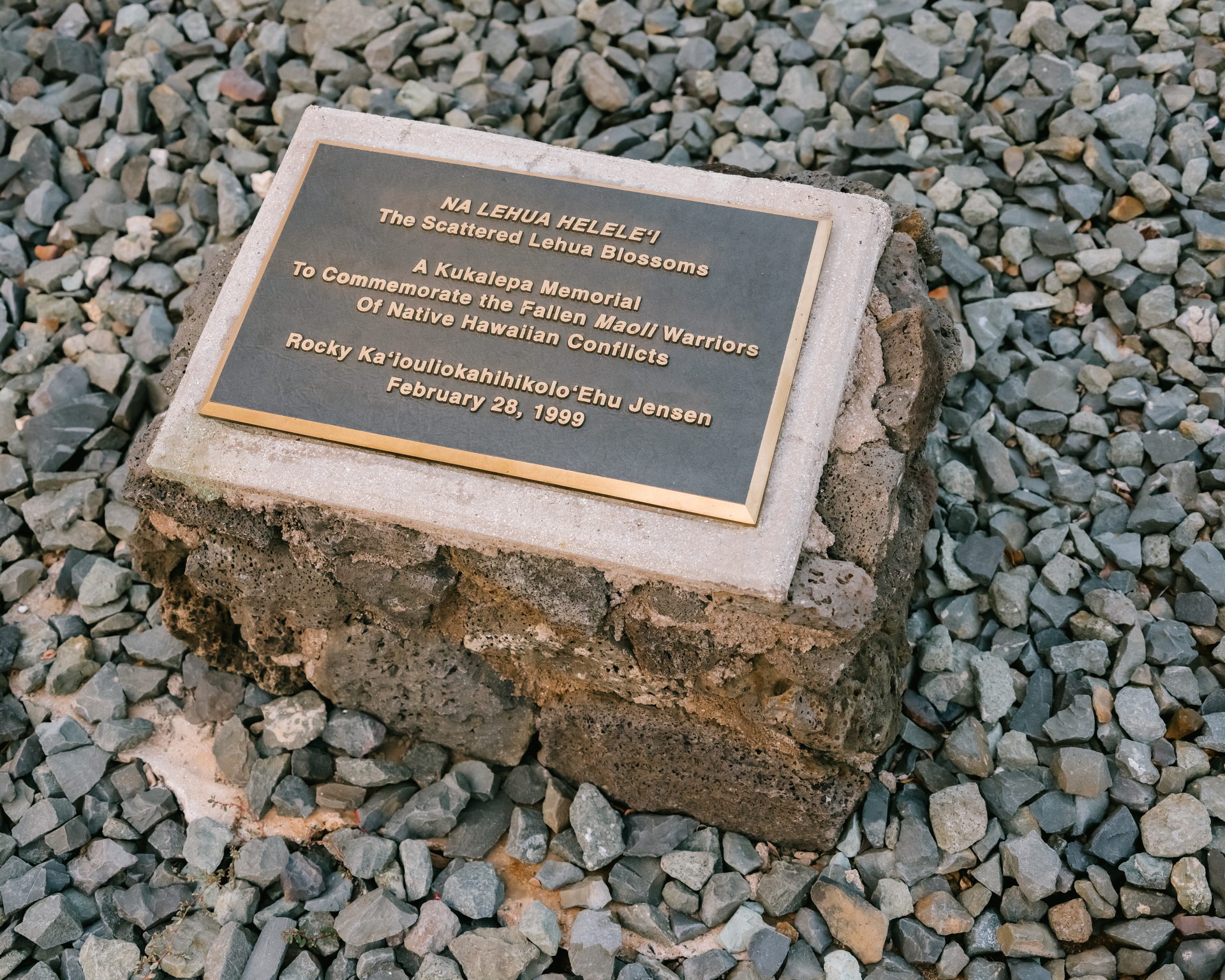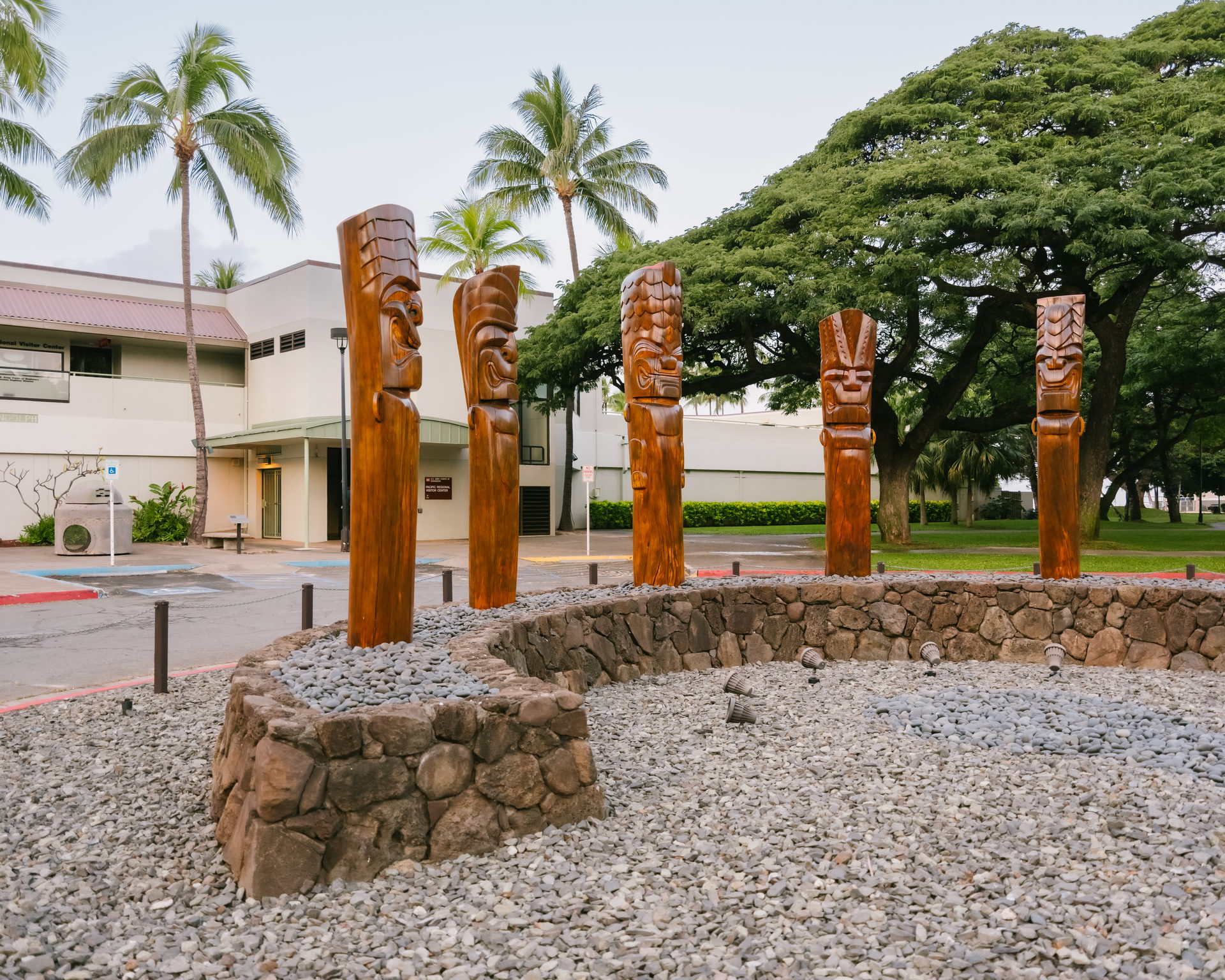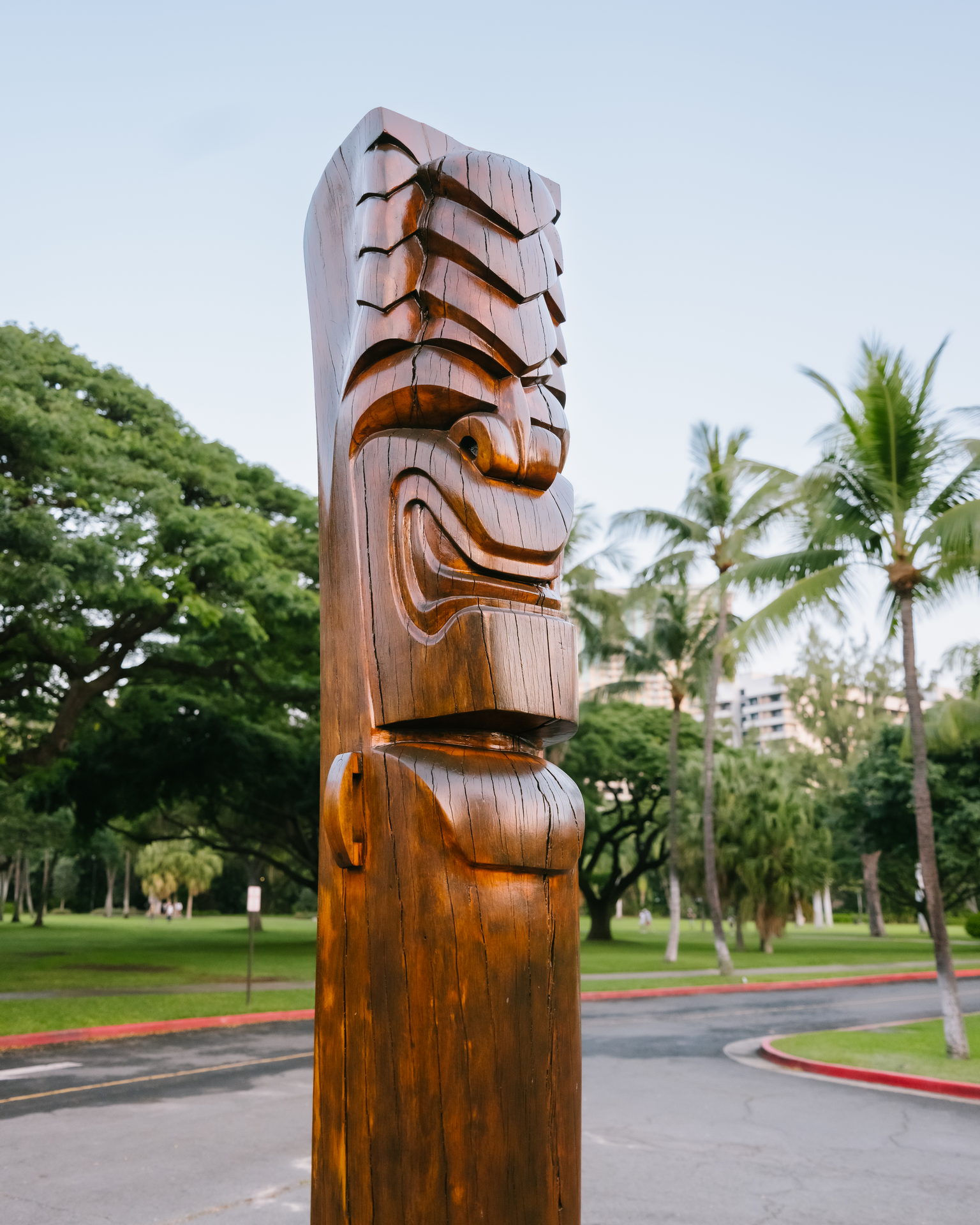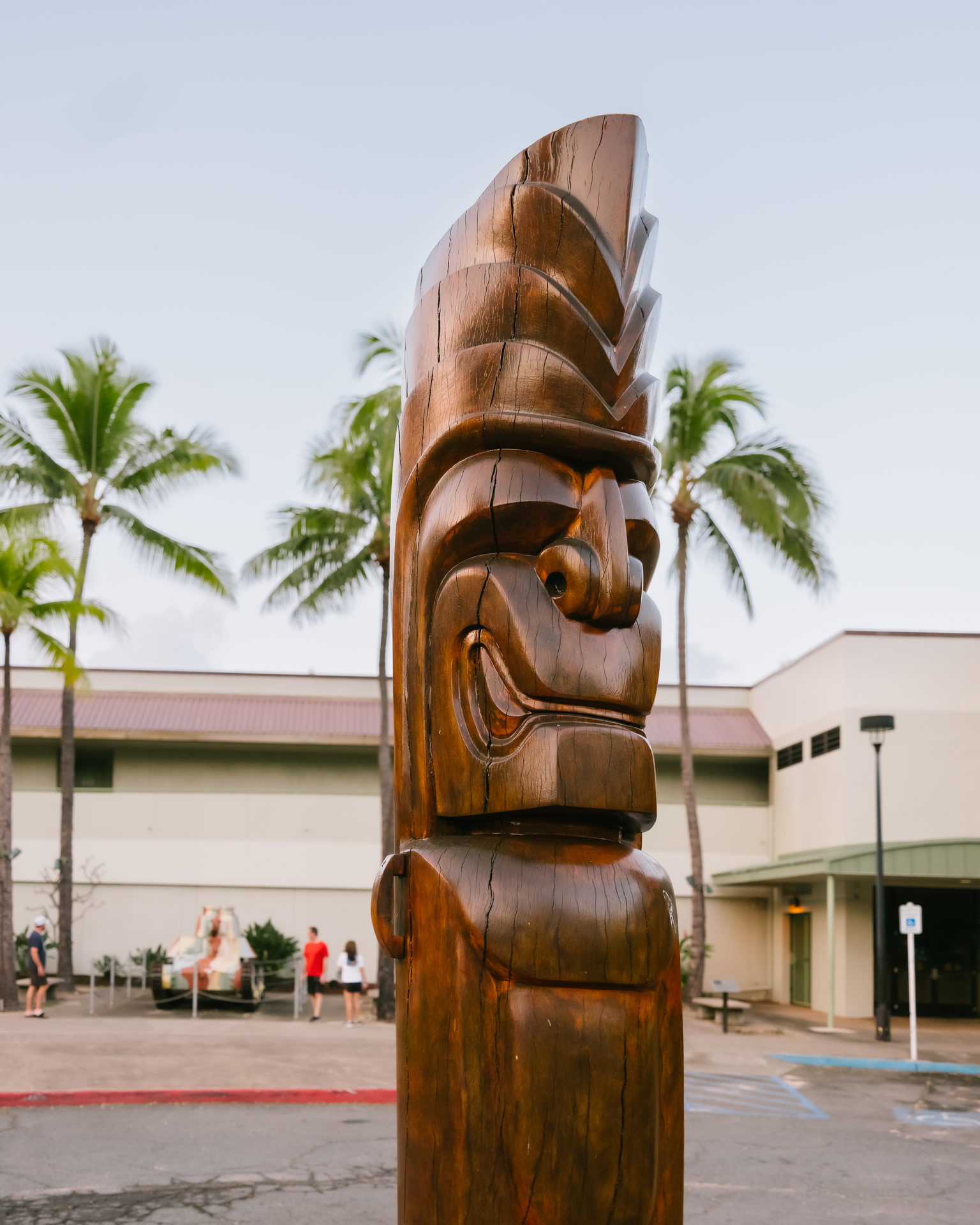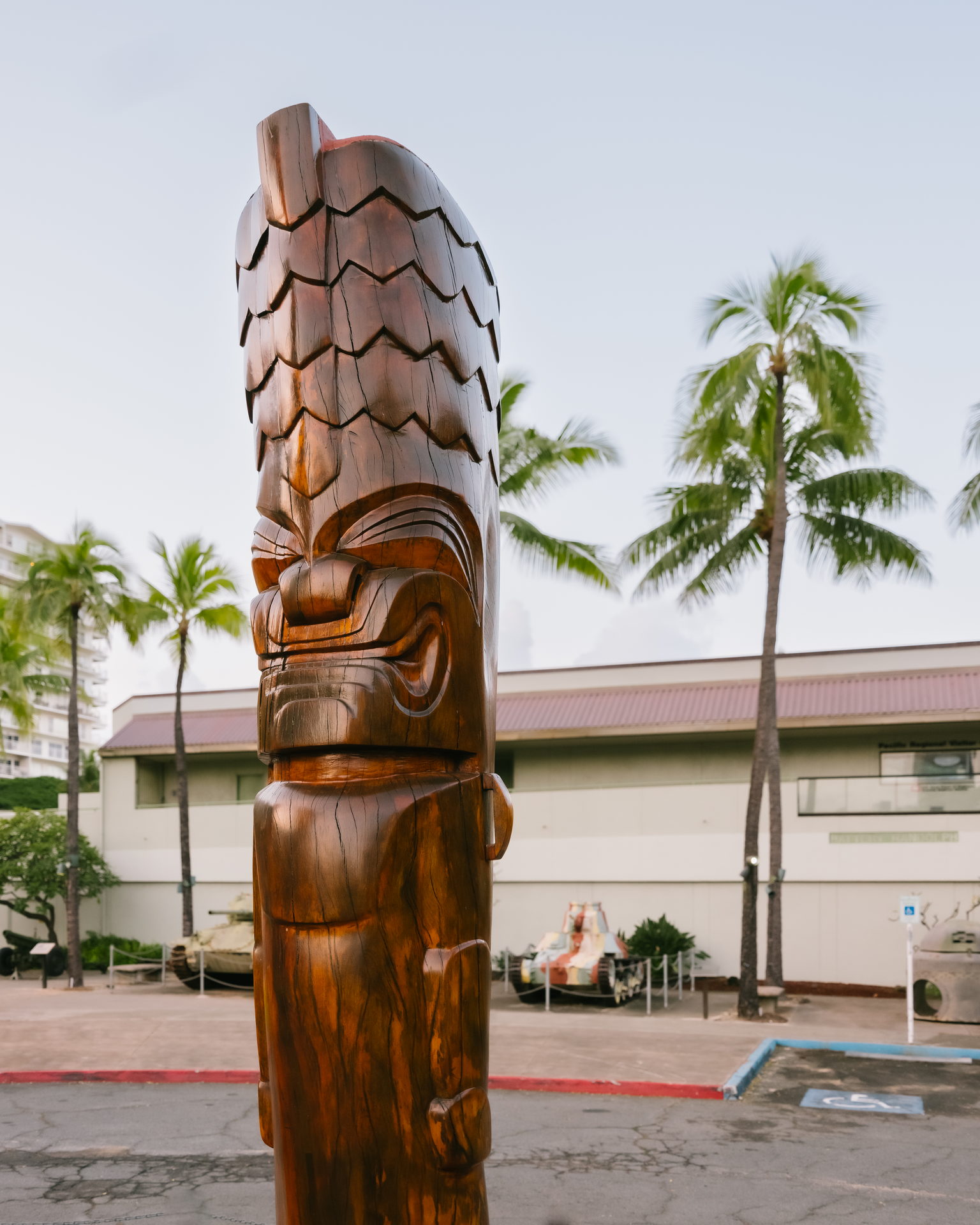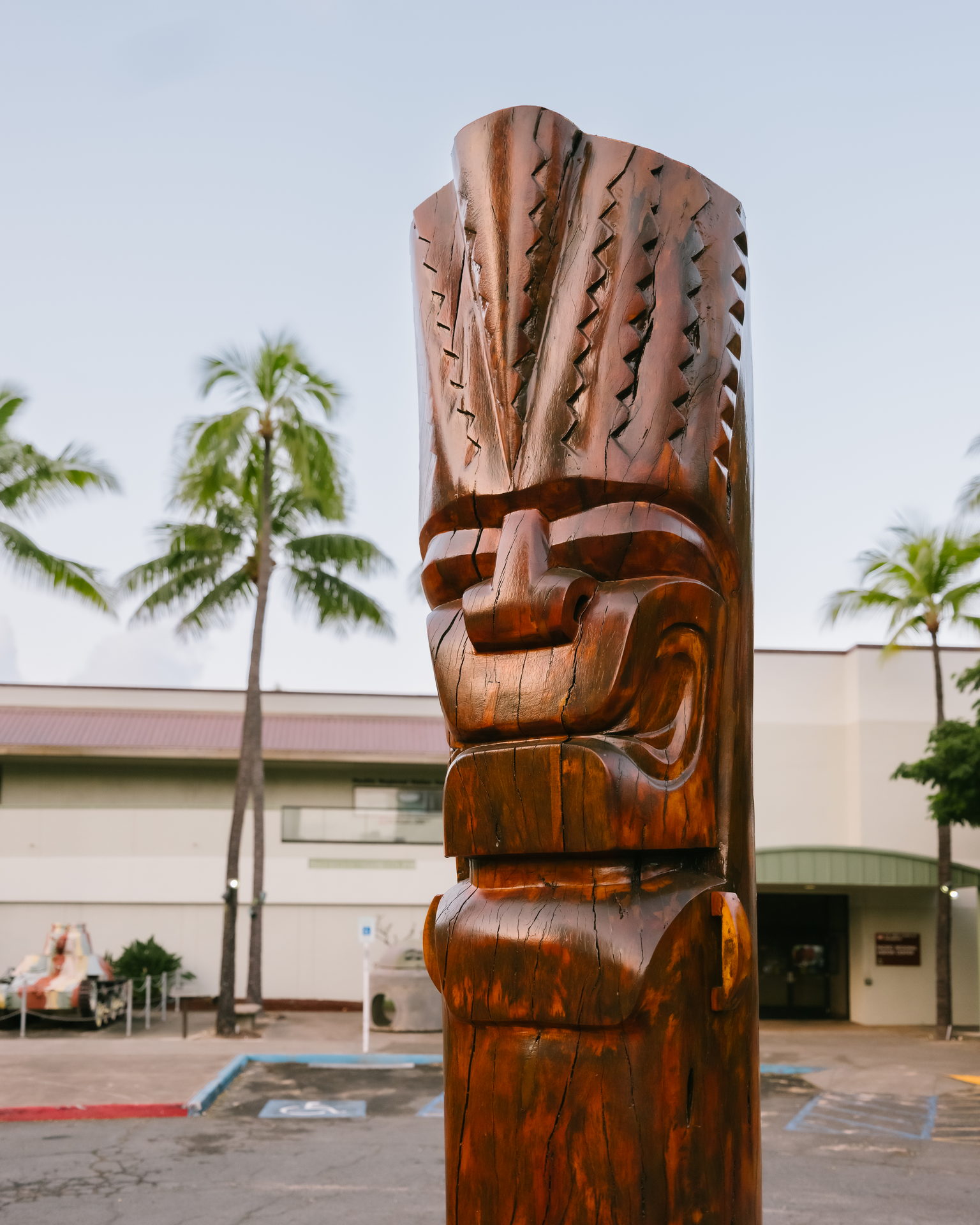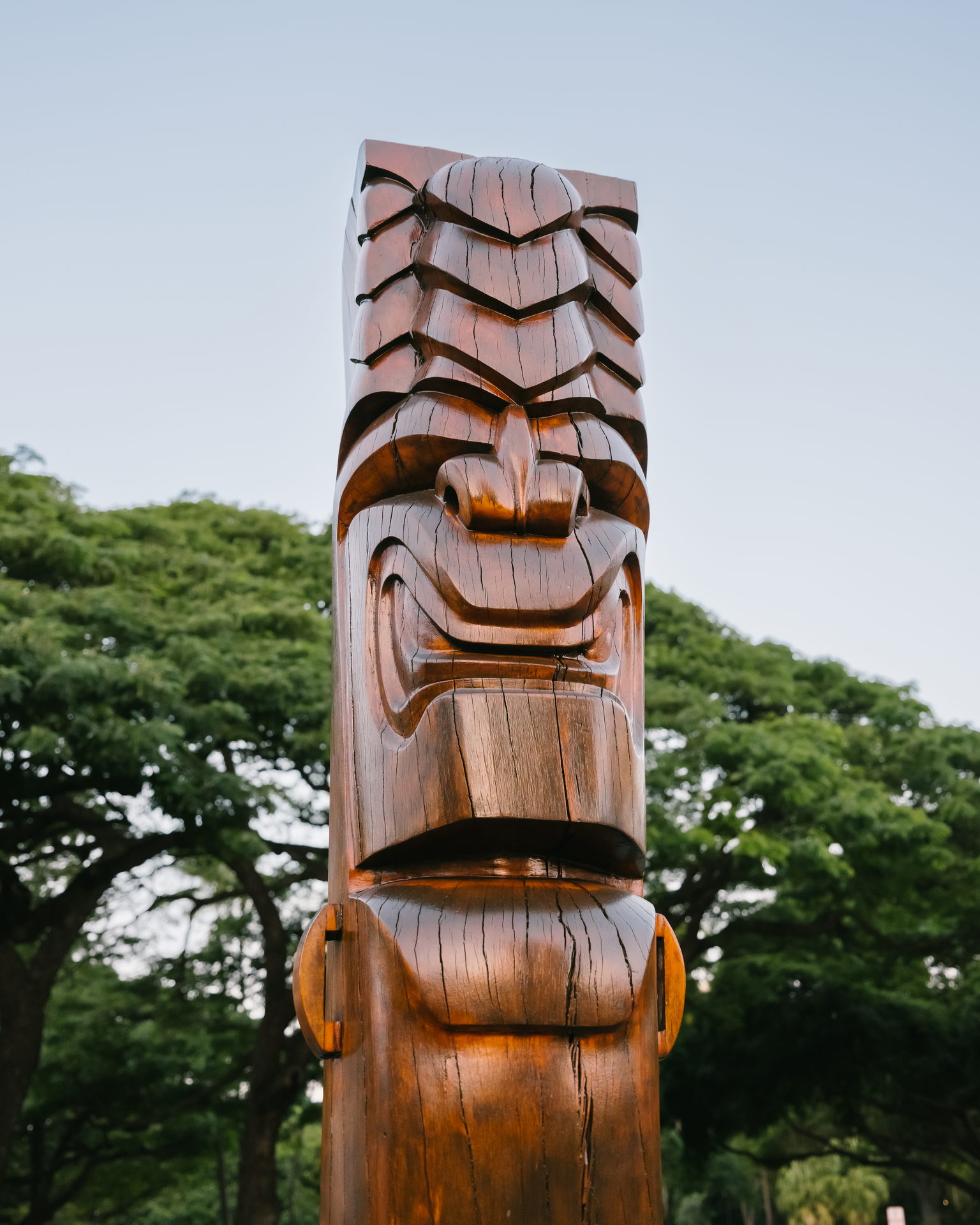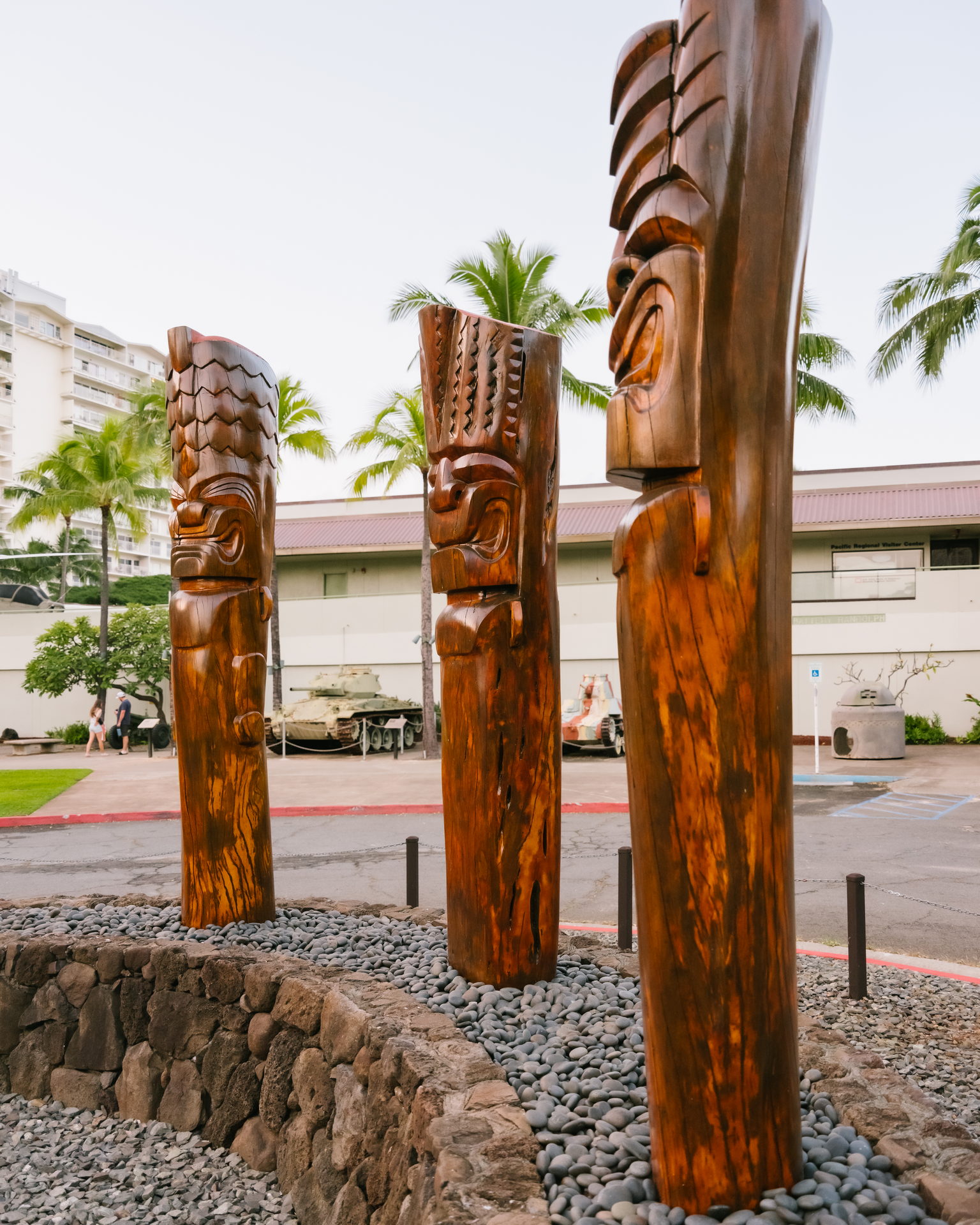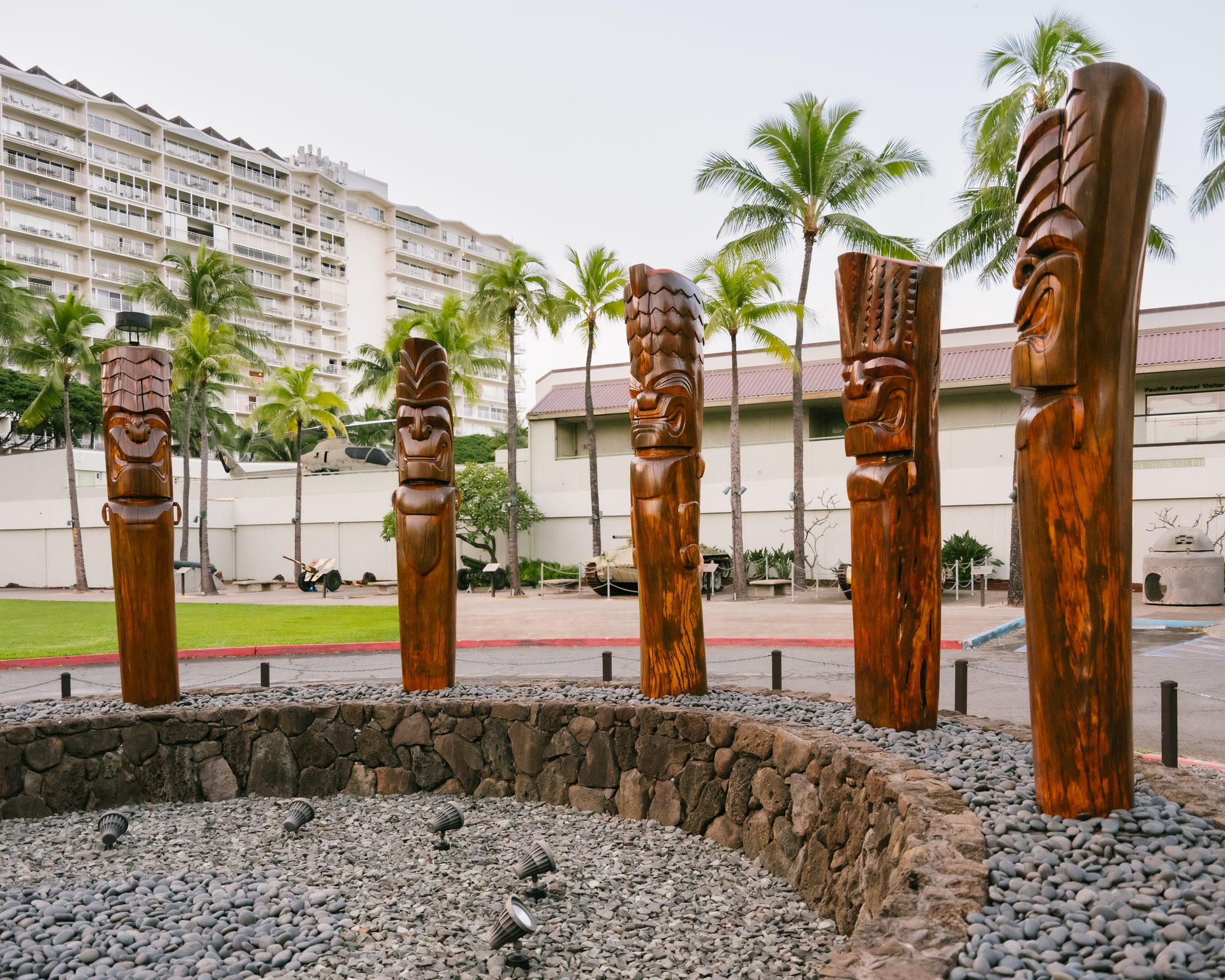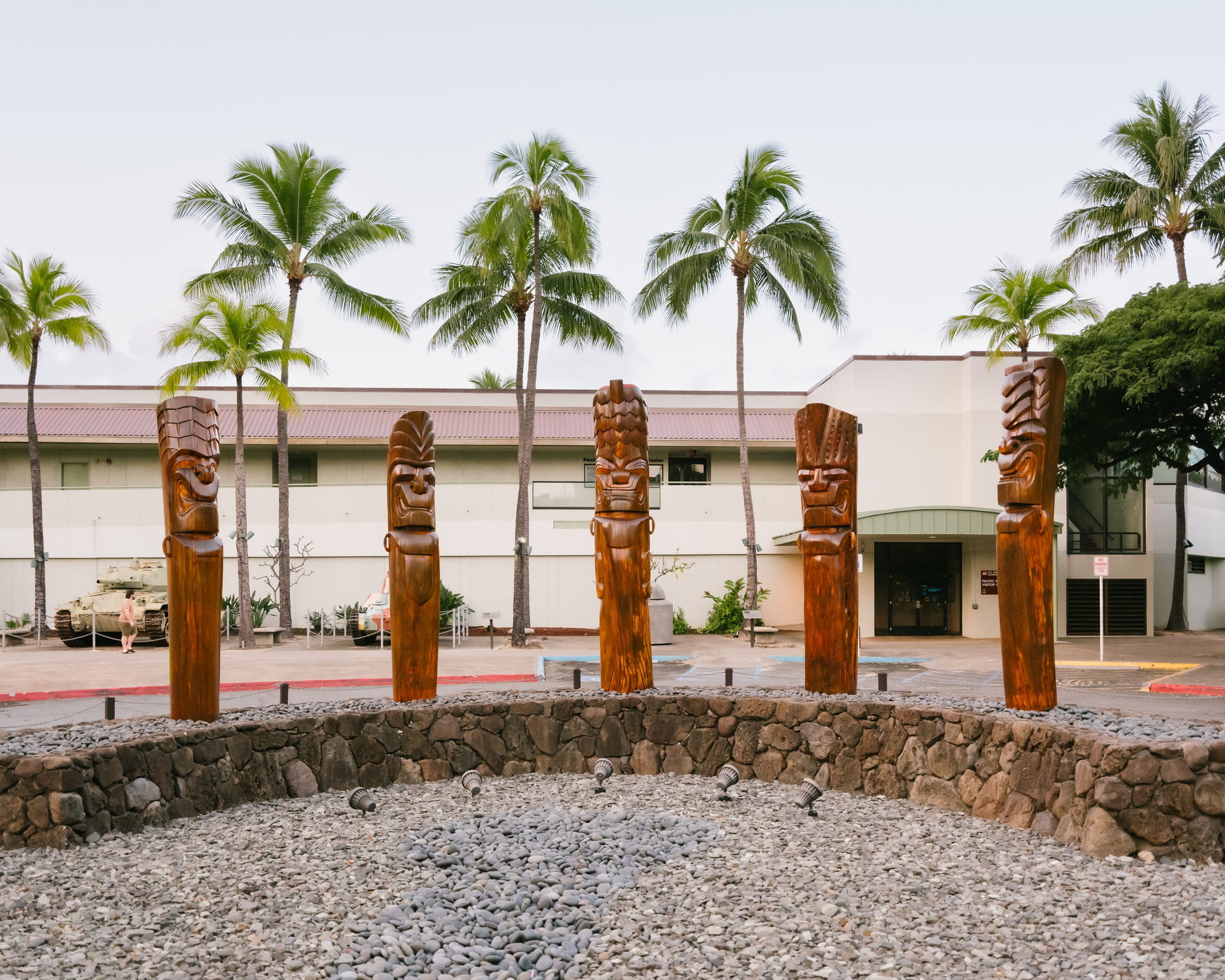ON THIS PAGE
Title
Na Lehua Helele‘i
The Scattered Lehua Blossoms (1999)
Artist(s)
Rocky KaʻiouliokahihikoloʻEhu Jensen
Site: 3
Fort DeRussy
Title
Na Lehua Helele‘i
The Scattered Lehua Blossoms (1999)
Artist(s)
Rocky KaʻiouliokahihikoloʻEhu Jensen
Na Lehua Helele‘i
The Scattered Lehua Blossoms (1999)
Situated in Waikīkī, in front of the US Army Museum of Hawai‘i at Fort DeRussy, Jensen’s five towering ki‘i, Nā Lehua Helele‘i, embody various aspects of the god Kū. Most often associated with warfare, each of these images of Kū instead represents his benevolent qualities like steadfastness, forgiveness, and generosity. Formed in a traditional kūkalepa, or crescent shape, they commemorate the fallen warriors of Kanaka Maoli conflicts and serve as a reminder of the enduring presence of Hawaiians both within and upon the land.
Twenty-five years after its initial installation and a year after Jensen’s passing in 2023, Nā Lehua Helele‘i was restored through the Wahi Pana project and with the volunteer support of the Royal Order of Kamehameha, an organization that preserves the rituals and memory of the ruling chiefs of Hawai‘i. This memorial also serves as a testament to Jensen’s legacy and persistence in gaining overdue recognition for Kānaka Maoli art.
Fort DeRussy
Ka‘imina‘auao Kahikina, Daniel Kauwila Mahi
The region of Waikīkī that includes Fort DeRussy is known as Kālia. Historically, Kālia was a rich and abundant area filled with rivers, taro patches, fish ponds, and springs. Its boundaries extend from the ʻEwa side of Piʻikoi Street to the Lēʻahi side of Kālakaua Avenue. Today, this vibrant landscape houses several iconic landmarks, such as the Ala Moana Shopping Center, Ala Moana Park, and Fort DeRussy.
Originally named Kawehewehe, the land where Fort DeRussy stands was once owned by Chief Kekūanāoʻa, a royal statesman. Kawehewehe was renowned for its life-giving stream, attracting sick individuals from across the archipelago seeking healing. It is said that many Hawaiians would travel there adorned with a lei limu kala, made from the seaweed kala. They would offer prayers asking their ancestors for forgiveness for past wrongdoings and release the lei into the water, symbolically letting go of their burdens and, in turn, finding healing.
Kawehewehe was also famous for its uluniu (coconut groves), which were connected to the well-known coconut groves of Helumoa. Water from the springs within the Kawehewehe stream supplied both freshwater and brackish ponds, making the area ideal for aquaculture and agriculture. Notable fish ponds included Kapuʻuʻiki, Kaʻihikapu, Kaʻōhai, Halemauliola, Kaipuni, Nā Loko Pāweo, and Nāmomoku.
In 1911, under an executive order from Governor Lucius E. Pinkham, the U.S. military took possession of seventy-one acres of land in Kālia. Shortly after, the fishponds at Kawehewehe were filled with cement to lay the groundwork for what is now known as Fort DeRussy. The fort and the surrounding area were named after General René Edward De Russy, a war general who served in the American Civil War. The army acquired additional land through executive orders from Governor Pinkham in 1917 and 1918. In 1975, the Hawaii Army Museum Society established a war museum that showcases war memorabilia and exhibits related to Hawaiʻi’s involvement in U.S. wars both abroad and locally.
Kālia also holds significant political history from the Hawaiian Kingdom. In 1828, Royal Governor Boki incited a revolt against Queen Kaʻahumanu, who served as Premier. Governor Boki was supported by American and British merchants opposed to Kaʻahumanu’s strict laws against prostitution, adultery, murder, and the production and consumption of alcohol. Armed and determined, Boki and the Hawaiian army marched into Kālia, prepared to confront the queen. His anger stemmed from jealousy, as Kaʻahumanu was closely involved in governing alongside the Mōʻī (King) Kauikeaouli. Moreover, she suggested that Chief Kekūanāoʻa’s daughter, Princess Ruth Keʻelikōlani, might be the next in line for the throne—an assertion Boki saw as an overreach of authority. He believed that the royal union between Princess Nahiʻenaʻena and King Kauikeaouli would lead to a more viable heir. The armed insurrection was ultimately quelled when Chief Kekūanāoʻa confronted Governor Boki. As a skilled statesman, Kekūanāoʻa played a crucial role in safeguarding the power of Queen Kaʻahumanu. Kekūanāoʻa would later father two kings, Lota Kapuāiwa and Alexander Liholiho, as well as one premier, Victoria Kaʻahumanu. He would also serve in various prestigious roles, including as a judge, Privy Council Member, President of the Legislature, royal governor of Oʻahu, President of the Board of Education, and the last premier of the Hawaiian Kingdom.
Today, Kawehewehe is encircled by towering hotels and high-rises, obscuring the once-thriving landscape of ponds and agricultural abundance. Once a sacred place of healing, its history is often lost beneath the urban skyline. Through the Wahi Pana project, Oʻahu is offered a deeper understanding of Kālia and Kawehewehe, restoring connections to this storied place and its enduring legacy of healing.

Rocky KaʻiouliokahihikoloʻEhu Jensen
Born in Honolulu in 1944, Rocky Jensen’s cultural foundation was shaped by time with his grandparents in Lāʻie, Oʻahu, and Pūkoʻo, Molokaʻi. After finishing school in Los Angeles, he returned to Hawaiʻi in 1968, studied at Leeward Community College, and took art classes at the Honolulu Academy of Arts. In 1970, he illustrated Men of Ancient Hawaiʻi and became a founding figure in the contemporary Native Hawaiian arts movement. Together with his wife Lucia, he established Hale Nauā III in 1975, the first Native Hawaiian arts organization made to support Hawaiian artists and protect the Hawaiian art form and its contemporary expressions. Hale Nauā III organized significant exhibitions, including the first contemporary Hawaiian art exhibit held at Honolulu Hale, AMFAC Gallery, Bishop Museum. While he struggled to find local recognition and faced a lack of support for Kānaka Maoli art, Rocky Jensen became one of the first Hawaiian contemporary artists to gain national and international attention, exhibiting at venues such as the Museum für Völkerkunde in Vienna in 1978. Later in his career, he received major commissions, including work for the U.S. Army Museum and ʻImiloa Astronomy Center. By the early 2000s, he had settled into a quieter life on Hawaiʻi Island with his wife and daughter, Natalie Mahina Jensen, who is also an artist.
Rocky passed away suddenly in September 2023. He is featured posthumously in the Wahi Pana project, where we honor his significant sculptural contributions at Fort DeRussy. The kiʻi also stand as a testament to Jensen’s legacy, triumph and persistence in bringing Kānaka Maoli art and artists into long-overdue recognition. The project, co-presented with HT25, showcases a range of his works, including several unfinished pieces, on display at Capitol Modern from February 5 to May 5, 2025.
Photos: Lila Lee
